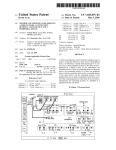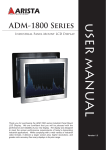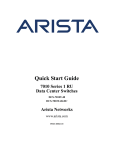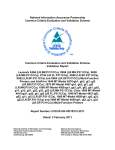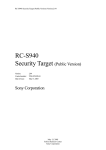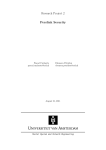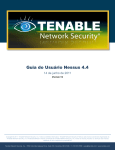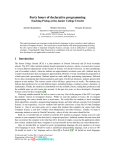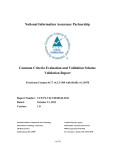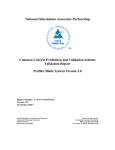Download Validation Report
Transcript
National Information Assurance Partnership Common Criteria Evaluation and Validation Scheme Validation Report Arista Networks Series 7150 with EOS 4.12.0.5 Report Number: CCEVS-VR-VID10523-2013 Dated: December 23, 2013 Version: 1.0 National Institute of Standards and Technology National Security Agency Information Technology Laboratory Information Assurance Directorate 100 Bureau Drive 9800 Savage Road STE 6940 Gaithersburg, MD 20899 Fort George G. Meade, MD 20755-6940 Acknowledgements Validation Panel Jerome F. Myers The Aerospace Corporation, 6940 Columbia Gateway Drive, Suite 400, Columbia, MD Kenneth B. Stutterheim The Aerospace Corporation, 6940 Columbia Gateway Drive, Suite 400, Columbia, MD Common Criteria Testing Laboratory Kenji Yoshino Marvin Byrd InfoGard Laboratories, Inc. San Luis Obispo, CA 2 Table of Contents 1 Executive Summary ......................................................................................5 2 Identification of the TOE ..............................................................................6 3 Interpretations .............................................................................................9 3.1 4 5 Security Policy ............................................................................................ 10 4.1 Audit ............................................................................................................................... 10 4.2 Cryptography .................................................................................................................. 10 4.3 User Data Protection ...................................................................................................... 11 4.4 Identification and Authentication .................................................................................. 11 4.5 Security Management .................................................................................................... 11 4.6 Protection of the TSF ...................................................................................................... 11 4.7 TOE Access...................................................................................................................... 12 4.8 Trusted Path/Channels ................................................................................................... 12 TOE Security Environment .......................................................................... 12 5.1 6 Clarification of Scope ....................................................................................................... 9 Secure Usage Assumptions ............................................................................................ 12 Architectural Information ........................................................................... 13 6.1 Architecture Overview ................................................................................................... 13 6.1.1 6.1.2 7 8 9 TOE Hardware ..................................................................................................................... 13 TOE Software ...................................................................................................................... 14 Documentation .......................................................................................... 14 7.1 Guidance Documentation .............................................................................................. 14 7.2 Security Target ............................................................................................................... 15 IT Product Testing....................................................................................... 15 8.1 Evaluation Team Independent Testing .......................................................................... 15 8.2 Vulnerability Analysis ..................................................................................................... 15 Results of the Evaluation ............................................................................ 16 10 Validator Comments/Recommendations.................................................... 16 11 Security Target ........................................................................................... 16 3 12 Terms ......................................................................................................... 16 12.1 Acronyms .................................................................................................................... 16 13 Bibliography ............................................................................................... 17 4 1 Executive Summary This report documents the National Information Assurance Partnership (NIAP) validation team’s assessment of the CCEVS evaluation of the Arista Networks 7150 Series with EOS 4.12.0.5. This Validation Report is not an endorsement of the Target of Evaluation by any agency of the U.S. government, and no warranty is either expressed or implied. The evaluation was performed by InfoGard Laboratories, Inc. in San Luis Obispo, California. The evaluation completed in December 2013. The evaluation team determined that the Arista Networks 7150 Series meets the assurance requirements specified by the Network Device Protection Profile, June 8, 2012, Version 1.1 and the Security Requirements for Network Devices Errata #1, December 19, 2013, Version 1.0. This report is intended to assist the end-user of this product with determining the suitability of this IT product in their environment. End-users should review both the Security Target (ST), which is where specific security claims are made, in conjunction with this Validation Report (VR), which describes how those security claims were evaluated. The TOE, the Arista 7150 Series: 7150S-24, 7150S-52, 7150S-64 with EOS V4.12.0.5, is a Network Device that provides layer 2, 3, and 4 Ethernet network management and interconnectivity. The Ethernet management layers refer to the Open Systems Interconnection (OSI) model layers. They refer to the data link, network, and transport layers respectively. It also contains a modern Linux-based operating system that allows for complex management solutions. It is designed with high performance electronics to meet the requirements of latencycritical applications such as financial Electronic Communication Networks (ECNs) or High Performance Computing (HPC) clusters. The TOE can direct and filter network packets based on the contents within each of these layers. It is also capable of supporting many modern layer-specific traffic management features including the following unevaluated features: • • • • • • • • • 802.1w, 802.1s Spanning Tree Protocol (STP) 802.3ad and Multi-Chassis Link Aggregation 802.3x Flow Control Virtual Local Area Networks (VLANs) IPv4/IPv6 routing and Network Address Translation (NAT) Access Control Lists (ACLs) Virtualization support (VXLAN and VMware) Quality of Service (QoS) rate limiting and queuing Congestion monitoring and management The TOE supports remote administration over the Secure Shell v2 (SSHv2) protocol that supports cryptographic encryption and authentication using FIPS-certified algorithms. The TOE also supports storage and forwarding of detailed audit logs. The process that manages audit messages is capable of forwarding audit messages, encrypted using SSHv2, to any syslogcompatible network entity. 5 2 Identification of the TOE Table 1 provides information needed to completely identify the product, including: • The Target of Evaluation (TOE), the fully qualified identifier of the product as evaluated; • The Security Target (ST), describing the security features, claims, and assurances of the product; • The conformance result of the evaluation; • The organizations and individuals participating in the evaluation; • The User Guidance, user facing documentation that is within the scope of the evaluation; • The Operational Environment, IT devices required to support the secure operation of the TOE. Evaluation Scheme United States Common Criteria Evaluation Validation Scheme Evaluated Target of Evaluation Arista 7150 Series Hardware Models Part Number Description DCS-7150S-24-F Arista 7150, 24x1/10G SFP+ switch, front-to-rear airflow, 2x AC PSU DCS-7150S-24-R Arista 7150, 24x1/10G SFP+ switch, rear-to-front airflow, 2x AC PSU DCS-7150S-24# Arista 7150, 24x1/10G SFP+ switch, no fans, no PSU (requires fans and power supplies from Table 2) DCS-7150S-24-CL# Arista 7150, 24x1/10G SFP+ switch, high precision clock, no fans, no PSU (requires fans and power supplies from Table 2) DCS-7150S-24-CLD# Arista 7150, 24x1/10G SFP+ switch, high precision clock, 50GB SSD, no fans, no PSU (requires fans and power supplies from Table 2) DCS-7150S-52-CL-F Arista 7150, 52x1/10G SFP+ switch, high precision clock, front-to-rear airflow, 2x AC PSU DCS-7150S-52-CL-R Arista 7150, 52x1/10G SFP+ switch, high 6 precision clock, rear-to-front airflow, 2x AC PSU DCS-7150S-52-CL# Arista 7150, 52x1/10G SFP+ switch, high precision clock, no fans, no PSU (requires fans and power supplies from Table 2) DCS-7150S-52-CLD# Arista 7150, 52x1/10G SFP+ switch, high precision clock, 50GB SSD, no fans, no PSU (requires fans and power supplies from Table 2) DCS-7150S-64-CL-F Arista 7150, 48x1/10G SFP+ & 4xQSFP+ switch, high precision clock, front-torear airflow, 2x AC PSU DCS-7150S-64-CL-R Arista 7150, 48x1/10G SFP+ & 4xQSFP+ switch, high precision clock, rear-tofront airflow, 2x AC PSU DCS-7150S-64-CL# Arista 7150, 48x1/10G SFP+ & 4xQSFP+ switch, high precision clock, no fans, no PSU (requires fans and power supplies from Table 2) DCS-7150S-64-CLD# Arista 7150, 48x1/10G SFP+ & 4xQSFP+ switch, high precision clock, 50GB SSD, no fans, no PSU (requires fans and power supplies from Table 2) Hardware Version (identical for all models) CPU: 03.02, Hardware: 04.00, Security Chip: R5H30211 Security hardware built into all Arista 7150 models. Software Arista EOS Version 4.12.0.5 Protection Profile Modular switch OS that separates switch state from protocol processing and application logic Network Device Protection Profile, June 8, 2012, Version 1.1 Security Requirements for Network Devices Errata #1, December 19, 2013, Version 1.0 Security Target Arista Networks Series 7150 Security Target, Version 1.9, Date December 23, 2013 7 Dates of Evaluation May 2013 – October 2013-December 2013 Conformance Result Pass Common Criteria Version v3.1 Revision 3 Common Evaluation Methodology (CEM) Version v3.1 Revision 3 Assurance Activities Report (AAR) Common Criteria Assurance Activity Report, Doc ID: 13-2624-R0030 V1.0 Sponsor/Developer Arista Networks, Inc. Common Criteria Testing Lab InfoGard Laboratories, Inc. (CCTL) CCTL Evaluators Kenji Yoshino, Marvin Byrd CCEVS Validators Jerome F. Myers, Kenneth B. Stutterheim Table 1: Evaluation Identification The following User Guidance is considered part of the TOE, delivered via electronic download, and within the scope of the evaluation: • Common Criteria Guidance Supplement Arista 7150 Series 1/10 GbE SFP Ultra Low Latency Switch Guidance Documents AGD_OPE.1, AGD_PRE.1, Version 1.9, Date: December 17, 2013 • Arista Quick Start Guide 7000 Series Data Center Switches, PDOC-00019-11 • User Manual Arista Networks, Arista EOS Version 4.12.0.5, Date: September 24, 2013 • Arista EOS System Message Guide, Software Release 4.12.0.5, September 13, 2013 This table identifies components that must be present in the Operational Environment to support the operation of the TOE. Component Description Syslog Server Syslog server conforming to RFC 5424 SSH server allowing port forwarding and supporting RSA 2048, AES128/256 CBC, HMAC-SHA1, and diffie-hellman-group14-sha1 NTP Server NTP server conforming to RFC 5095 SSH Client SSHv2 client supporting RSA 2048, AES-128/256 CBC, HMAC-SHA1, and diffie-hellman-group14-sha1 RS-232 Terminal Serial console supporting 9600 baud, no flow control, 1 stop bit, no parity bits, and 8 data bits SPF Interfaces 8 40GBASE-CR4 QSPF+ 40 Gb/s 40GBASE-SR4 QSPF+ 40 Gb/s 40GBASE-LR4 QSPF+ 40 Gb/s 10GBASE-CR SPF+ 10 Gb/s 10GBASE-SRL SPF+ 10 Gb/s 10GBASE-SR SPF+ 10 Gb/s 10GBASE-LR SPF+ 10 Gb/s 10GBASE-ER SPF+ 10 Gb/s 10GBASE-DWDM SPF+ 10 Gb/s 1GbE-SX SPF+ 1 Gb/s 1GbE-LX SPF+ 1 Gb/s 1GbE-TX SPF+ 1 Gb/s 100Mb-TX SPF+ 100 Mb/s Fan and Power Supply Modules1 FAN-7000-F Front-to-rear airflow fan module FAN-7000-R Rear-to-front airflow fan module PWR-460AC-F 460 Watt AC PSU with front-to-rear airflow PWR-460AC-R 460 Watt AC PSU with rear-to-front airflow PWR-460DC-F 460 Watt DC PSU with front-to-rear airflow PWR-460DC-R 460 Watt DC PSU with rear-to-front airflow Table 2: Operational Environment Components 3 Interpretations The Evaluation Team performed an analysis of the international interpretations of the CC and the CEM and determined that none of the International interpretations issued by the Common Criteria Interpretations Management Board (CCIMB) were applicable to this evaluation. The TOE is also compliant with all international interpretations with effective dates on or before May 22, 2013. 3.1 Clarification of Scope The TOE claims exact compliance to the Network Device Protection Profile, June 8, 2012, 1 A power supply and fan module is required for the models ending in #. 9 Version 1.1. Exact compliance indicates that the TOE implements the security functions exactly as specified by the PP; however, functions not described in the Security Target may be used but were not tested as part of this evaluation. 4 Security Policy This section contains the product features and denotes which are within the logical boundaries of the TOE. The following Security Functions are supported by the TOE: • • • • • • • • 4.1 Audit Cryptography User Data Protection Identification and Authentication Security Management Protection of the TSF TOE Access Trusted Path/Channels Audit The Arista EOS uses an internal syslog process that receives, stores, and forwards auditable events from all system processes. When a user or system process triggers applicable TSF functionality an audit message is generated, and sent to the internal syslog process. These events are then sent to an external audit server for storage and review by an administrator. The communication between the TOE and external audit server is protected by tunneling the syslog protocol through an encrypted SSH tunnel. 4.2 Cryptography The TSF performs the following cryptographic operations: • • • • • SSH with the following algorithms: o RSA-2048 for public-key authentication (FIPS algorithm Cert. #1315) o AES-128/256 CBC for data encryption (FIPS algorithm Cert. #2567) o HMAC-SHA1 for data integrity (FIPS algorithm Cert. #1584) o diffie-hellman-group14-sha1 for key exchange SHA-512 for the following purposes: (FIPS algorithm Cert. #2163) o Local administrator password storage and authentication o CLI “verify” function which allows the SHA-512 hash calculation of any file SHA-1 for the following purposes: (FIPS algorithm Cert. #2163) o Used within HMAC-SHA1 and diffie-hellman-group14-sha1 HMAC-SHA1 for the following purposes: (FIPS algorithm Cert. #1584) o SSH data verification Random bit generation using FIPS 140-2 X9.31-AES (FIPS algorithm Cert. #1218) 10 4.3 User Data Protection The TOE uses various software and hardware mechanisms to ensure that network packets traveling through the TOE are not re-used or accessible once they have finished being used by the TOE. The hardware packet-routing architecture is built without the use of padding to ensure that all data is passed between components exactly as-is. Therefore, when an Ethernet packet is received by the switch, the exact size of the packet is known and allocated for in global memory. When a packet is stored within global memory it is stored along with metadata to ensure packet integrity. The Linux kernel API, which handles padding in a safe manner, is leveraged to generate packets internally. If the kernel is given a payload that does not meet the minimum payload size requirement it will pad the payload with zeros. In addition, the kernel will not accept payloads with a bit length non-divisible by eight. Therefore, each individual system process is responsible for creating a payload that does not require padding past the minimum length requirement. These features together protect user data from being disclosed. 4.4 Identification and Authentication The TOE supports password authentication for administrative users over console and SSH. The TOE also supports RSA key-based authentication for administrative users over SSH. The TOE stores the local system administrator password locally using SHA-512 hashing and allows special characters and passwords in excess of 15 characters. The remote authentication server stores the privilege level of each user along with all other information required to access the TOE. The TOE enforces that administrative users authenticate through this mechanism before performing any administrative actions. Communications between the TOE and the external authentication server are protected by an encrypted SSH TCP tunnel between both systems. 4.5 Security Management The TOE enforces protection of TSF data with encrypted and authenticated network communications. The TOE also performs self-tests on boot to verify that each of these cryptographic algorithms are functioning correctly. 4.6 Protection of the TSF The TOE protects TSF data from disclosure using different cryptographic methods and securityfunctionality. The TOE provides administrative access to users through a CLI that enforces user and group profiles. The administrator configures user profiles on the authentication server that specify varying degrees of access to the system. The limited CLI, user account system, and underlying file system permissions serve to restrict access to TSF data such as private keys. Plaintext private keys used for SSH authentication are stored on internal flash which is only accessible through CLI commands performed by the local administrator. The local administrator password stored by the TOE is kept in a hashed form so that it cannot be read in plaintext format. 11 The TOE derives a reliable time source for logging and other system processes through the local NTP service. The exact time can be provided by setting the value locally, or through synchronizing the time from an external server via NTP. When updating TSF functionality, a published cryptographic hash of the updated software is provided to the user to ensure the integrity of the software. The TOE is also able to verify that TSF protection is functioning properly by running a memory test at boot-time and several diagnostic tools throughout the operation of the TOE. During the EOS boot sequence the TOE also initializes FIPS self-tests which utilize known-answer tests against each cryptographic algorithm supported by the TOE. 4.7 TOE Access In order to prevent unauthorized access to the TOE, administrative sessions can be terminated manually or automatically. If an administrator accesses the TOE the session may be terminated by the administrator’s own actions or automatically after a specified time of inactivity. These termination features apply to both local and remote connections to the TOE. The TOE will also display a customizable warning message that is displayed to the user during each administrative logon. The message can serve as an advisory notice and consent warning regarding use of the TOE. 4.8 Trusted Path/Channels The TOE implements and requires a secured method of communication between itself, external devices, and remote administrators. In order to accomplish a secure connection to external devices, the TOE uses an SSHv2 connection with RSA based authentication and AES-based encryption. A private/public key pair can either be generated by the TOE or imported from another device and imported into the TOE. After an SSHv2 connection is authenticated via RSA key pairs, AES encryption keys are exchanged via diffie-hellman-group14-sha1 key exchange algorithm. After these steps, all further traffic between the TOE and the external device is encrypted via AES-128/256-CBC encryption. This method provides assured identification of the external device and prevents disclosure or undetected modification of data across the communication channel. Communications between the TOE and external devices may be initiated from either the TOE or the external device. Remote administrators may also create a secured connection to the TOE that provides cryptographic authentication and protection of data. Remote administrators connecting to the TOE via SSHv2 have the option of using password-based authentication or RSA key-based authentication. 5 TOE Security Environment 5.1 Secure Usage Assumptions The following assumptions are made about the usage of the TOE: 12 A.NO_GENERAL_PURPOSE It is assumed that there are no general-purpose computing capabilities (e.g., compilers or user applications) available to the TOE, other than those services necessary for the operation, administration and support of the TOE. A.PHYSICAL Physical security, commensurate with the value of the TOE and the data it contains, is assumed to be provided by the environment. A.TRUSTED_ADMIN TOE Administrators are trusted to follow and apply all administrator guidance in a trusted manner. 6 Architectural Information The TOE is classified as a Network Device for Common Criteria purposes. The TOE is made up of hardware and software components. The TOE is an ultra-low latency and feature rich network switch that is intended to connect many Ethernet-based network devices together in an enterprise environment while maintaining security, reliability, and wire-speed network connections. 6.1 Architecture Overview Each non-administrative network interface uses a small form-factor pluggable (SFP) transceiver to provide connectivity between the network device motherboard and a fiber optic or copper cable. This allows the customer to use several different types of network cables with the network device. The list of compatible SFPs is provided in Table 1 and the user guidance. Each model of the TOE under evaluation varies by the amount and type of SFPs supported by the hardware. The 7150S-24 supports 24 separate SFP+ modules, the 7150S-52 supports 52 separate SFP+ modules, and the 7150S-64 supports 48 separate SFP+ modules and 4 Quad Small Form-factor Pluggable (QSFP+) modules. The Arista Extensible Operating System, or Arista EOS, is built upon the mainline Linux kernel (www.kernel.org) and an x86 dual-core CPU. 6.1.1 TOE Hardware The TOE hardware is one of the following models: • DCS-7150S-24-F • DCS-7150S-24-R • DCS-7150S-24# • DCS-7150S-24-CL# • DCS-7150S-24-CLD# • DCS-7150S-52-CL-F • DCS-7150S-52-CL-R 13 • DCS-7150S-52-CL# • DCS-7150S-52-CLD# • DCS-7150S-64-CL-F • DCS-7150S-64-CL-R • DCS-7150S-64-CL# • DCS-7150S-64-CLD# All of these models use CPU: 03.02, Hardware: 04.00, Security Chip: R5H30211 6.1.2 TOE Software The TOE software is Arista EOS v4.12.0.5. 7 Documentation This section details the documentation that is (a) delivered to the customer, and (b) was used as evidence for the evaluation of the Arista 7150 Series. In these tables, the following conventions are used: • Documentation that is delivered to the customer is shown with bold titles. • Documentation that was used as evidence but is not delivered is shown in a normal typeface. • Documentation that is delivered as part of the product but was not used as evaluation is shown with a hashed background. The TOE is shipped to the customer using a standard parcel service. The guidance documents are provided via electronic download and apply to the CC Evaluated configuration: 7.1 Guidance Documentation Document Revision Date 1.9 December 17, 2013 Arista Quick Start Guide 7000 Series Data Center Switches PDOC00019-11 N/A User Manual Arista Networks, Arista EOS Version 4.12.0.5 N/A September 24, 2013 Arista EOS System Message Guide, Software Release 4.12.0.5 N/A September 13, 2013 Common Criteria Guidance Supplement Arista 7150 Series 1/10 GbE SFP Ultra Low Latency Switch Guidance Documents AGD_OPE.1, AGD_PRE.1 14 7.2 Security Target Document Revision Date 1.9 December 23, 2013 Arista Networks Series 7150 Security Target 8 IT Product Testing This section describes the testing efforts of the Developer and the Evaluation Team. 8.1 Evaluation Team Independent Testing The evaluation team performed all of the test activities specified in the Network Device Protection Profile, June 8, 2012, Version 1.1 and the Security Requirements for Network Devices Errata #1, December 19, 2013, Version 1.0. The test environment consisted of: • centos 6.2 final o rsyslog 5.8.12 o OpenSSH 5.3p1, OpenSSL 1.0.0-fips 29 Mar 2010 • debian-7.0.0-amd64 o ntpd 4.2.6p5 o OpenSSH 6.0p1, OpenSSL 1.0.1e 11 Feb 2013 The TOE passed all required test activities. 8.2 Vulnerability Analysis On September 12, 2013, the evaluation team searched http://www.cvedetails.com for known vulnerabilities in: • Linux version 2.6.38.8.Ar-1398415 • OpenSSH_5.5p1 • OpenSSL 1.0.0e-fips 6 Sep 2011 • ntpd version 4.2.6p3-RC10 • Arista EOS 4.12.0 The evaluation team determined that suitable vulnerabilities would have Low CVSSv2 Access Complexity, because a Medium Access complexity as defined by http://www.first.org/cvss/cvssguide.html#i2.1.2 requires additional access, social engineering, and/or a non-default configuration. The evaluation team found three potential vulnerabilities. Of the three potential vulnerabilities, a public exploit has only been released for one of the vulnerabilities. The evaluation team ran the one exploit against the TOE and determined the TOE was not vulnerable. 15 9 Results of the Evaluation The evaluation was carried out in accordance with the Common Criteria Evaluation and Validation Scheme (CCEVS) processes and procedures. The TOE was evaluated against the criteria contained in the Common Criteria for Information Technology Security Evaluation, Version 3.1 Revision 3. The evaluation methodology used by the Evaluation Team to conduct the evaluation is the Common Methodology for Information Technology Security Evaluation, Version 3.1 Revision 3. InfoGard has determined that the TOE meets the security criteria in the Security Target, which specifies an assurance requirements specified in Network Device Protection Profile, June 8, 2012, Version 1.1. A team of Validators, on behalf of the CCEVS Validation Body, monitored the evaluation. The evaluation was completed in October 2013. 10 Validator Comments/Recommendations The evaluation team’s assessment of the evaluation evidence demonstrates that the claims in the ST are met. Additionally, the evaluation team’s test activities also demonstrated the accuracy of the claims in the ST. The evaluation team worked closely with the validation team to resolve issues arisen during the consistency review – including retesting and re-scoping of the evaluation. It is important to note for that the TOE’s default “admin” account is outside of the scope of evaluation after configuration has been completed (other than to provide system updates, maintenance and user management). The validation team’s assessment of the evidence provided by the evaluation team is that it demonstrates that the evaluation team performed the assurance activities in the NDPP, and correctly verified that the product meets the claims in the ST. 11 Security Target Arista Networks Series 7150 Security Target, Version 1.9, Date December 23, 2013. 12 Terms 12.1 Acronyms AAA Authentication Authorization and Accounting AAR Assurance Activity Report CC Common Criteria CSP Critical Security Parameters DAC Discretionary Access Control FIPS Federal Information Processing Standards Publication 140-2 16 I/O Input/Output NIST National Institute of Standards and Technology OCSP Online Certificate Status Protocol PP Protection Profile QSFP Quad Small Form-factor Pluggable SF Security Functions SFR Security Functional Requirements SFP Small Form-factor Pluggable SSH Secure Shell ST Security Target STP Spanning Tree Protocol TOE Target of Evaluation TSF TOE Security Functions 13 Bibliography [1] Common Criteria for Information Technology Security Evaluation – Part 1: Introduction and general model, dated July 2009, Version 3.1 Revision 3, CCMB-2009-07-001. [2] Common Criteria (CC) for Information Technology Security Evaluation – Part 2: Security functional components, July 2009, Version 3.1, Revision 3, CCMB-2009-07-002. [3] Common Criteria for Information Technology Security Evaluation – Part 3: Security assurance components, July 2009, Version 3.1, Revision 3, CCMB-2009-07-003. [4] Common Methodology for Information Technology Security Evaluation – Evaluation methodology, July 2009, Version 3.1, Revision 3, CCMB-2009-07-004. [5] Network Device Protection Profile, June 8, 2012, Version 1.1. [6] Security Requirements for Network Devices Errata #1, December 19, 2013, Version 1.0 17
























